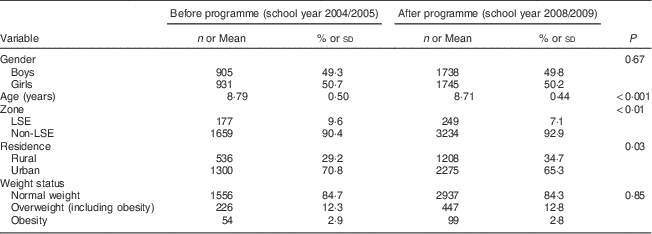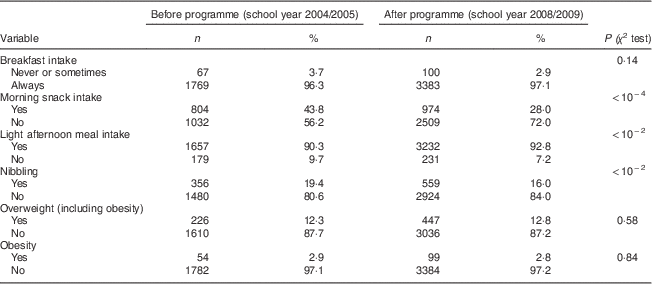Obesity has been recognized as a major public health epidemic by the WHO since 1998( 1 ) and is a well-established risk factor for several chronic diseases( Reference Dudina, Cooney and Backer 2 – Reference L’Allemand-Jander 4 ). Over the past few years, the prevalence of overweight and obesity has increased dramatically among children and adolescents both in developed countries and other parts of the world( Reference Jolliffe 5 – Reference Wang and Lobstein 7 ). Several local and national studies in France have shown that overweight prevalence among children aged 5–17 years increased from 3 % in 1965 to 5 % in 1980, 12 % in 1996 and 16 % in 2000( Reference Girardet, Bocquet and Bresson 8 , 9 ). Since the 2000s, a study carried out on representative samples of French children has shown that overweight prevalence on a national scale seems to have stabilized at about 16 %( 10 – Reference Salavane, Peneau and Rolland-Cachera 12 ). Obesity is known to be a multifactorial problem resulting from a reduction in physical activity( Reference Riddoch, Bo Andersen and Wedderkoop 13 , Reference Hills, Andersen and Byrne 14 ) and changes in dietary habits( Reference Maffeis 15 – Reference Diethelm, Jankovic and Moreno 17 ). Several studies have shown that the principal risk factors for childhood overweight include parental obesity, low socio-economic status (SES), low physical activity, high level of sedentary activities and inappropriate diet such as the consumption of fatty and sugary foods( Reference Hills, Andersen and Byrne 14 , Reference Juonala, Juhola and Magnussen 18 , Reference Thibault, Carriere and Langevin 19 ). In France, the National Program on Nutrition and Health (PNNS) was launched by the Ministry of Health in 2001( Reference Girardet, Bocquet and Bresson 8 , Reference Hercberg, Chat-Yung and Chauliac 20 ). One of its main objectives is to stop the increase in the prevalence of childhood obesity in France. Various public health actions for improving dietary habits and physical activity in children have been implemented. In accordance with the objectives and tools of the PNNS, a multidisciplinary public health programme called ‘Nutrition, Prevention and Health for children and teenagers in Aquitaine’ (www.nutritionenfantaquitaine.fr) was launched in November 2004 in Aquitaine (south-west France) to improve the diet and physical activity of children and adolescents and to stabilize the prevalence of childhood obesity, by means of three key strategies( Reference Thibault, Boulard and Carriere 21 ):
-
1. early detection, prevention and management of childhood obesity by mobilizing stakeholders in Aquitaine;
-
2. improvement of the food supply in middle schools and implementing extracurricular activities; and
-
3. implementation of educational programmes on food and physical activity aimed at children, their families, and their educational and medical communities.
Before launching the programme, a study was conducted in 2004–2005 among 7·5–10·5-year-old children in order to guide the intervention and to provide baseline data on dietary habits, lifestyle, and overweight and obesity prevalence. Four years later, the study was repeated in order to evaluate the impact of the programme on children’s lifestyle.
The objective of the present study was therefore to describe changes in overweight and obesity prevalence and dietary behaviour among 7·5–10·5-year-old children in Aquitaine from 2004 to 2008 and to assess the impact of the programme ‘Nutrition, Prevention and Health of children and teenagers in Aquitaine’ on this evolution.
Methods
Study design and participants
Two cross-sectional surveys were conducted in 2004 and 2008 on representative samples of primary schools randomly selected in Aquitaine. Stratification variables were the district, the size of the school, the area of residence (urban or rural) and the zone category (low socio-economic (LSE) or non-LSE). Schools selected for each study could be different.
The surveys were conducted on children of the same age group:
-
1. before implementation of the programme (2004/2005 school year), sample called ‘before programme’ (163 schools); and
-
2. after implementation of the programme (2008/2009 school year), sample called ‘after programme’ (210 schools).
All the children in third grade from the selected schools who were seen by the school nurse during the annual health check were included in the samples. Children aged less than 7·5 years or more than 10·5 years old were excluded from the analysis for the sake of homogeneity. Parents were informed of the survey and only children whose parents agreed were included in the study.
Data were collected by means of a questionnaire (see Appendix) completed by the school nurse in the presence of the child during the health check. Data transmitted for the analysis were anonymous.
Data collection and measurements
Weight status
Weight status was determined from weight and height measurements collected by school nurses. Weight and height were measured by school nurses in the morning or the afternoon (fasting was not necessary) using standardized procedures and measurement devices. Weight was measured with the child lightly dressed, without shoes, and with the school health centre scales; height was measured with the child standing up, his/her weight being equally distributed on both feet, with head, back and buttocks on the vertical part of the height gauge. Weight status was determined by BMI, calculated from measured weight and height data transmitted by school nurses as follows: BMI=[weight (kg)]/[height (m)]2. Weight status (normal, overweight or obesity) was attributed with the International Obesity Task Force definition( Reference Cole, Bellizzi and Flegal 22 ) according to the BMI, gender and age of the child.
Eating habits
In both surveys, eating habits of children were assessed by school nurses who collected information on their usual breakfast intake (always, sometimes or never), morning snack intake (yes or no), light afternoon meal intake (yes or no) and nibbling habits (yes or no; in the present study, ‘nibbling’ refers to eating something between the light afternoon meal (food intake recommended for children) and dinner). The composition of each dietary intake was also described.
School socio-economic status
In France, state-run schools are described by the school administration as LSE (low SES) or non-LSE (non-low SES), according to their socio-economic characteristics( 23 , 24 ). LSE schools have a high rate of school failure or are located in specific geographical areas (rural area, suburbs of big cities) where socio-economic difficulties are prevalent (including low SES of families). At the age of 5–10 years, most children go to school in the area where they live and their school address can be used as an indicator of SES of the area of residence.
Other variables
Children’s age and gender were collected for both surveys. According to the National Institute for Statistics and Economic Studies, the area of residence is classified as urban if continuously built up and accommodating 2000 persons or more. Rural populations are all those not classified as urban.
Statistical analysis
Data registration was performed using EpiData software. Differences between samples were assessed by the χ 2 test or the Kruskal–Wallis test. All statistical tests were two-sided and a P<0·05 was considered statistically significant. Models were fitted using the SAS statistical software package version 9·1·3. Multivariate analyses were used and odds ratios were calculated to assess the effect of the regional programme intervention on the evolution of overweight and obesity prevalence and eating habits independently.
Results
Study population
The response rate of schools was 89·0 % in 2004/2005 and 92·4 % in 2008/2009. The ‘before programme’ sample included 1836 children and the ‘after programme’ sample included 3483 children, for whom both weight status and dietary habits were known.
Characteristics of both samples are described in Table 1. For both samples, the male:female ratio was close to 1 (P=0·67). In the ‘before programme’ sample, the mean age of children and the rates of children who lived in low-SES areas and urban areas were slightly higher than in the ‘after programme’ sample (P<0·05). Thus, results concerning the evolution of weight status and dietary behaviour after 4 years of programme implementation were adjusted for age, area of residence (rural/urban) and SES of the living zone in a multivariate analysis.
Table 1 Characteristics of children from the third grade before (n 1836) and after (n 3483) implementation of the prevention programme. Cross-sectional surveys in primary schools in the Aquitaine region, France

LSE, low socio-economic.
Evolution of eating habits among children before and after the prevention programme
Four years after the prevention programme, eating habits had changed globally (Table 2). The proportion of children who usually took a light afternoon meal had increased significantly (P<0·01) while morning snack intake and nibbling had decreased significantly (P<0·01). Moreover, the number of children who took breakfast had stabilized (P=0·14; Table 2).
Table 2 Eating habits and prevalence of overweight and obesity in third-grade children before (n 1836) and after (n 3483) implementation of the prevention programme. Cross-sectional surveys in primary schools in the Aquitaine region, France

These results persisted after adjustment for age, area of residence and SES of the living zone: the increase in light afternoon meals (OR=1·38; 95 % CI 1·13, 1·69, P=0·002) and the decrease in morning snack intake (OR=0·50; 95 % CI 0·45, 0·57, P<0·001) and nibbling (OR=0·81; 95 % CI 0·70, 0·93, P<0·001) persisted (Table 3).
Table 3 Summary of associations found between weight status and eating habits and programme intervention between 2004/2005 and 2008/2009 among third-grade children in the Aquitaine region, France: multivariate logistic regression analysis (n 5319)

Model adjusted for year of intervention, area of residence, zone category and age.
Moreover, the evolution was generally favourable with regard to the composition of breakfast, light afternoon meals and morning snacks. Fewer chocolates, candies and pastries were consumed (from 17·6 % to 12·6 % at morning snack intake and from 17·7 % to 10·3 % for light afternoon meals, P<0·0001), while there was a significant increase in fruit consumption (from 18·7 % to 32·8 % for morning snack intake and from 20·1 % to 26·6 % for light afternoon meals, P<0·0001).
Evolution of overweight and obesity prevalence before and after the programme
The overall prevalence of overweight (including obesity) and obesity stabilized between 2004/2005 and 2008/2009 (P=0·85; Table 1). After adjustment for age, area of residence and SES of the living zone, the stabilization of overweight including obesity (OR=1·05; 95 % CI 0·89, 1·23, P=0·56) and obesity (OR=0·99; 95 % CI 0·71, 1·39, P=0·96) persisted (Table 3).
Discussion
The present study shows that overweight (including obesity) and obesity prevalence of children aged 7·5–10·5 years stabilized in Aquitaine (south-west France) between 2004/2005 and 2008/2009. This stabilization, which was the main objective of both the regional and national programmes for nutrition and health( Reference Hercberg, Chat-Yung and Chauliac 20 , Reference Thibault, Carriere and Baine 25 ), is consistent with recent studies conducted at national level in France among 7–9-year-old children( Reference Salavane, Peneau and Rolland-Cachera 12 ), in other European countries( Reference Jeannot, Mahler and Duperrex 26 – Reference Olds, Maher and Zumin 29 ) and in the USA, China and Australia( Reference Olds, Maher and Zumin 29 ).
Moreover, qualitative and quantitative improvements in children’s dietary habits were also observed between 2004/2005 and 2008/2009. First, the proportion of children having a light afternoon meal (usually after class, around 16.00 hours) increased between the two periods studied. Because of the duration of the school day in France, this light afternoon meal is recommended for children. The protective effect of the afternoon meal has been described previously and may be explained by a better distribution of energy intake, thus avoiding nibbling between lunch and dinner( Reference Bellisle, Rolland-Cachera and Deheeger 30 ). On the other hand, the proportion of children having a morning snack or nibbling decreased. Many studies report that the foods eaten in morning snacks and nibbling are often fatty and sweet and have a negative impact on food balance( Reference Bellisle, Rolland-Cachera and Deheeger 30 , Reference Bocquet, Bresson and Breind 31 ). Finally, a slight but non-significant increase was observed in breakfast intake. This could be due to the fact that the percentage of children having breakfast every day in 2004/2005 was already high (96·3 %).
These changes in dietary habits among Aquitaine children are consistent with nationwide nutritional recommendations made by the PNNS and relayed regionally by the programme ‘Nutrition, Prevention and Health for children and teenagers in Aquitaine’, especially though the dissemination of flyers concerning the importance of taking breakfast and an afternoon meal and cutting out morning snacks( Reference Thibault, Carriere and Baine 25 , Reference Thibault, Carriere and Langevin 32 ).
Actions undertaken on the basis of the PNNS( Reference Girardet, Bocquet and Bresson 33 ) and the nutrition programme in Aquitaine( Reference Thibault, Carriere and Baine 25 ) could be responsible for the stabilization of overweight and the improvement in dietary behaviour among 7·5–10·5-year-old children in Aquitaine. Besides promoting healthy dietary habits, other actions undertaken in Aquitaine, such as early detection of overweight and encouraging a physically active lifestyle, could also have played a part( Reference Thibault, Carriere and Langevin 32 ). However, since there was no control group, we cannot even partly attribute the stabilization of overweight and obesity prevalences from 2004/2005 to 2008/2009 and improvement in dietary behaviour to the Aquitaine prevention programme. Moreover, the studies were performed on the same age group but not on the same children: in 2008/2009, some children in third grade had already benefited from health education campaigns in their first year in school, so they were more likely to have better dietary habits than those included in the first study. However, in most studies describing recent stabilization of overweight and obesity prevalence, the trend was associated with national, regional and/or local actions that had been implemented in many sectors of society( Reference Girardet, Bocquet and Bresson 33 , Reference Sjoberg, Moraeus and Yngve 34 ).
Another limitation of the present study is the fact that lifestyle habits were not assessed, especially physical activity and sleep, which are recognized as factors for obesity in children( Reference Lioret, Touvier and Lafay 35 , Reference Spiegel 36 ). Data on physical activity and sedentary lifestyle were collected but only in the second study in 2008/2009. Consequently, any changes in the physical activity of children could not be assessed between 2004/2005 and 2008/2009.
No sleep data were collected because children’s assessment of their quality or duration of sleep is not necessarily reliable and in order to limit the time taken by school nurses to administer the survey.
On the other hand, one of the strengths of our study is the large representative samples studied in both analyses. Indeed, by conducting this survey at school, we were able to collect anthropometric data on a large number of children of the same age but with different lifestyles and SES. Another study strength is that data were collected by school health professionals, thereby ensuring high-quality data compared with self-reported data or multicentre measurements.
In addition, the multivariate analysis was adjusted for characteristics known to have an influence on overweight prevalence: age (increase in overweight prevalence with age)( 10 ), area of residence (higher prevalence of overweight among rural children)( Reference Sjoberg, Moraeus and Yngve 34 , Reference Bruner, Lawson and Pickett 37 , Reference Liu, Bennett and Harun 38 ) and especially SES of the living zone. Indeed, previous studies have shown that the stabilization of overweight prevalence seems to differ according to SES of the population, with a more significant slowing down of the increase in prevalence in non-low SES areas( Reference Peneau, Salavane and Maillard-Teyssier 39 ).
These findings reinforce the relevance of implementing public health programmes such as the PNNS and the Aquitaine programme. Furthermore, they underline the importance of implementing and pursuing interventions in primary schools in order to achieve consistent behavioural changes, as recommended by recent international( 1 , 16 ), national( Reference Hercberg, Chat-Yung and Chauliac 20 , Reference Girardet, Bocquet and Bresson 33 ) and regional policies. New data are now needed to continue to assess the evolution of overweight and obesity prevalence and dietary behaviour among children in the Aquitaine region.
Acknowledgements
Acknowledgements: The authors thank the school nurses and doctors who collected and recorded measurements during child health surveillance, and all partners from the Local Education Authority of the Aquitaine region involved in the programme ‘Nutrition, Prevention and Health of children and teenagers in Aquitaine’. Financial support: This study was funded by the national health insurance scheme and the Regional Health Agency of Aquitaine as part of funding allocated to the Aquitaine programme for nutrition, prevention and health. The funders had no role in the design, analysis or writing of this article. Conflict of interest: None. Authorship: H.T. was responsible for the conception, design, interpretation of the data, and writing and revising the manuscript. C.C. contributed to the design and interpretation of data and performed the analysis, writing and revising of the manuscript. C.L. contributed to writing and revising the manuscript. E.K.D. contributed to the analysis. P.B.-G. contributed to the interpretation and revised the manuscript. S.M. revised the manuscript. All authors have read and approved the final manuscript. Ethics of human subject participation: All data were anonymous: children’s identity was not transmitted. Parents were informed of the study.
Appendix
Questionnaire used for the study (translated from French)






